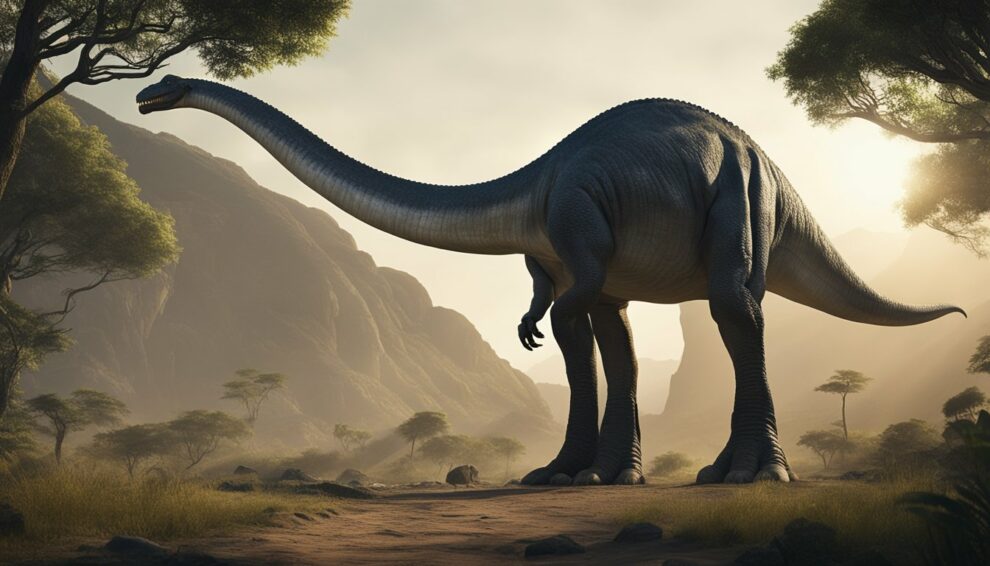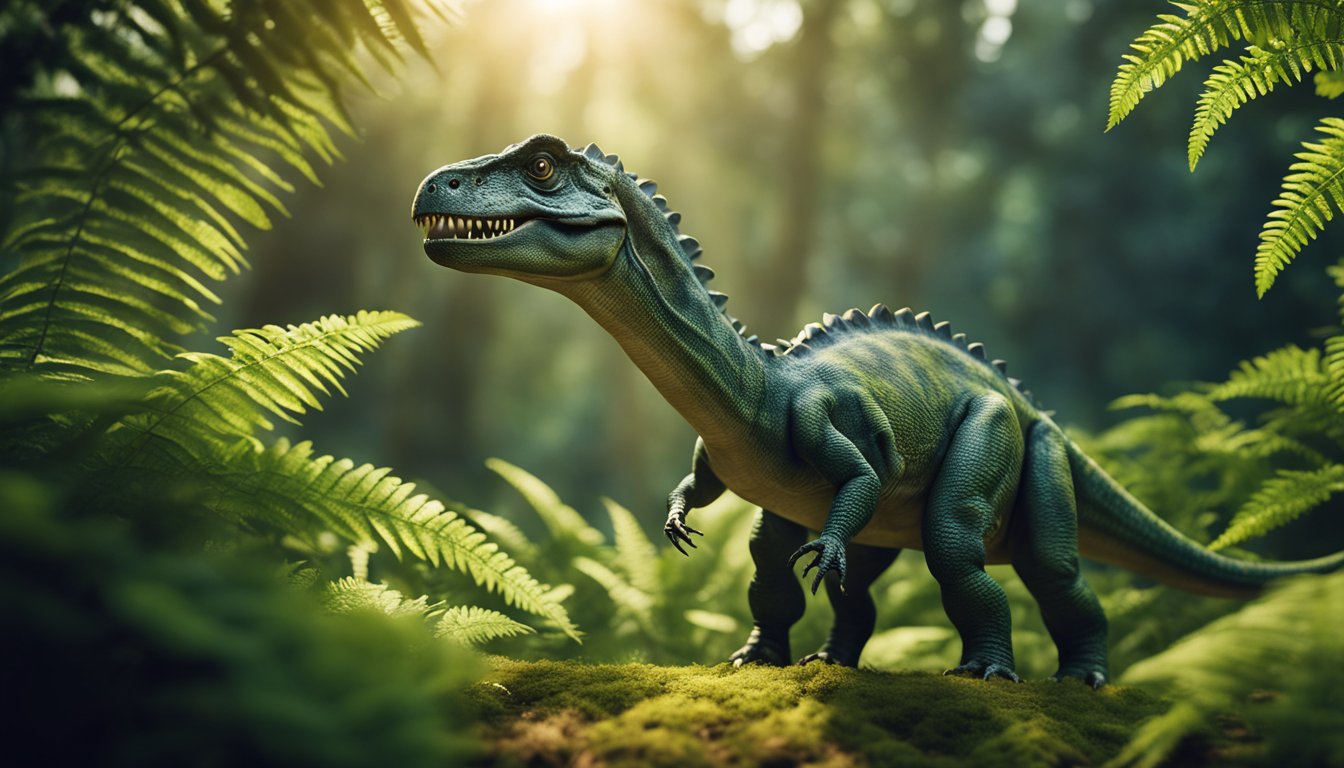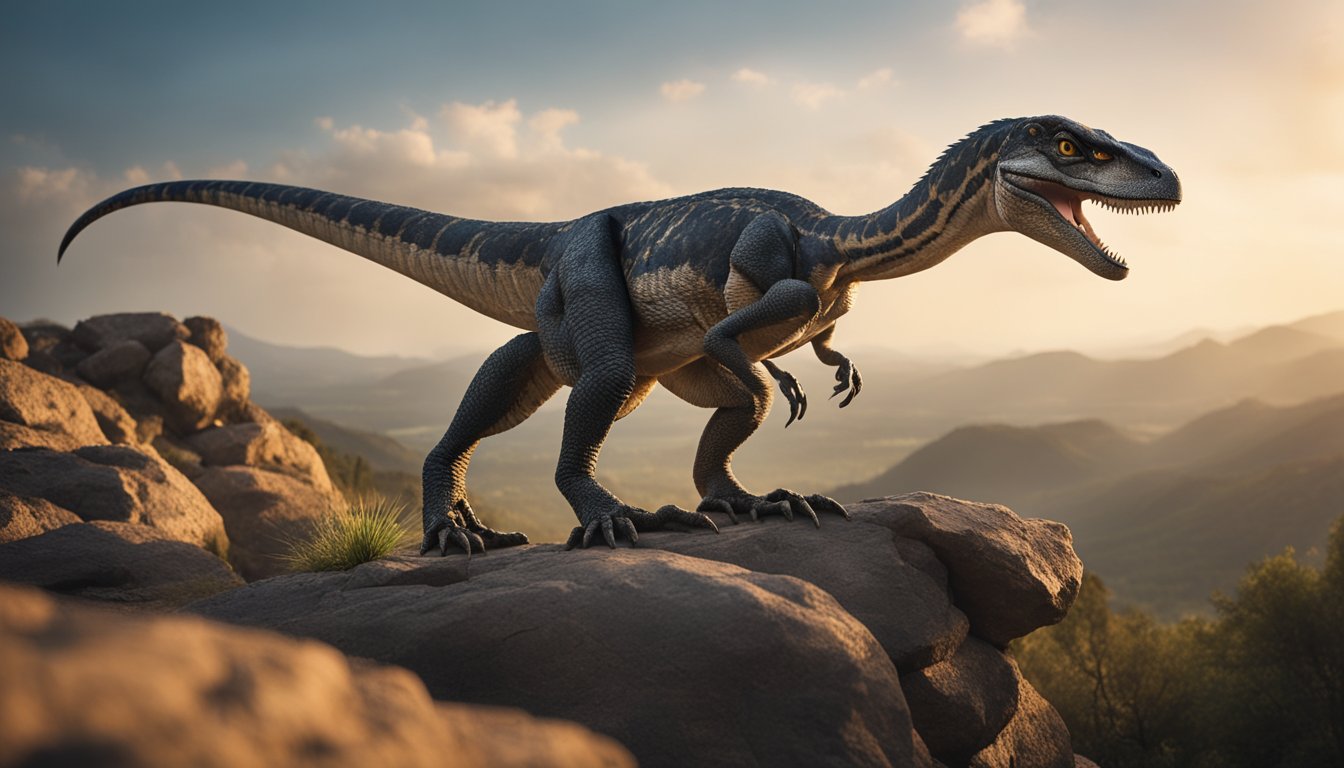Barosaurus, the long-necked giant dinosaur, is one of the most fascinating creatures to have ever roamed the earth.
Its impressive size and unique features made it an awe-inspiring sight to behold.
Barosaurus was a type of sauropod, known for their long necks and tails, and was one of the largest animals to have ever lived.

The Barosaurus had an incredibly long neck, which it used to reach high up into trees to eat leaves and other vegetation.
Despite its size, the Barosaurus had a relatively small head, which meant that it had to eat a lot of food to sustain its massive body.
Its long neck was made up of 15-16 vertebrae, which were up to 39 inches long. This made the Barosaurus’s neck longer than any other dinosaur’s.
Barosaurus was one of the most successful dinosaurs of its time, and it was able to survive for millions of years despite the many predators that roamed the earth.
Its long neck allowed it to reach food that other animals couldn’t, and its massive size made it difficult for predators to take down.
Despite its size, the Barosaurus was a gentle giant, and it spent most of its time grazing on plants and avoiding danger.
Unveiling the Barosaurus
Discovery and History
Barosaurus, the giant long-necked dinosaur, was first discovered by Paleontologist Othniel Charles Marsh in 1889.
Marsh was a prominent paleontologist of his time and worked for the American Museum of Natural History.
He named the dinosaur Barosaurus, which means “heavy lizard,” due to its massive size and weight.
The first Barosaurus fossils were found in the Morrison Formation, a geological formation in western North America known for its rich deposits of dinosaur fossils.
Marsh discovered the first Barosaurus fossil in 1889 in Wyoming, USA. Since then, several more fossils have been found in other parts of North America.
Anatomy of a Giant
The Barosaurus was a massive dinosaur, measuring up to 24 meters in length and weighing around 20 tons.
Its most distinctive feature was its long neck, which could reach up to 14 meters in length.
The neck was composed of 15 vertebrae, each of which was up to 1 meter long.
The Barosaurus had a relatively small head, a long tail, and a bulky body.
It was a herbivore and used its long neck to reach high branches and leaves that other herbivorous dinosaurs could not access.
The dinosaur had powerful hips, a short body, and short legs, which made it more agile than other sauropods.
The Barosaurus fossils are among the most well-preserved dinosaur fossils ever found.
Paleontologists have been able to study the bones in great detail, which has provided valuable insights into the anatomy and behavior of this giant dinosaur.
In conclusion, the discovery of Barosaurus fossils has provided valuable insights into the anatomy and behavior of these giant long-necked dinosaurs.
Paleontologists continue to study these fossils to learn more about the history of life on earth.
The Life of a Long-Necked Sauropod

Barosaurus, the giant long-necked dinosaur, was a herbivorous sauropod dinosaur that lived during the Late Jurassic period.
These majestic creatures roamed the earth over 150 million years ago and were known for their incredibly long necks.
In this section, we will explore the diet, habitat and range, behavior and social structure of this fascinating creature.
Diet and Feeding Habits
Barosaurus was a herbivore and had a unique diet that consisted of plants such as ferns and conifers.
Its long neck allowed it to reach high up into trees to reach leaves and branches that other herbivorous dinosaurs could not access.
Barosaurus had to consume large amounts of vegetation to sustain its massive body, and it is estimated that it could consume up to 500 pounds of plants per day.
Habitat and Range
Barosaurus lived in North America during the Late Jurassic period and its fossils have been found in Utah and South Dakota.
They lived in the Morrison Formation, which was a vast area of floodplains and forests.
The climate was warm and humid, and the area was rich in vegetation, making it an ideal habitat for Barosaurus.
Behavior and Social Structure
Barosaurus was a social animal that lived in herds.
They had a unique way of communicating with each other, using low-frequency sounds that could travel long distances.
They also had a unique way of defending themselves against predators, using their massive tails as a whip to fend off attackers.
In conclusion, Barosaurus was a fascinating creature that defied predators with its long neck and massive size.
Its unique diet, habitat, and behavior make it a fascinating subject of study for paleontologists and dinosaur enthusiasts alike.
Barosaurus in the Ecosystem

Barosaurus was a giant herbivorous dinosaur that lived during the Late Jurassic period, around 150 million years ago.
It was a member of the sauropod family, which included other long-necked giants such as Diplodocus and Apatosaurus.
Barosaurus was one of the largest animals to ever walk the earth, weighing up to 40 tons and measuring up to 88 feet in length.
Coexistence with Other Dinosaurs
Barosaurus lived in a diverse ecosystem that included a variety of other dinosaurs.
Some of the other herbivorous dinosaurs that lived alongside Barosaurus included Stegosaurus, Camarasaurus, and Brachiosaurus.
These dinosaurs likely competed for resources such as food and water, but they also may have formed herds for protection against predators.
Predators and Survival Strategies
Barosaurus faced a variety of predators during its lifetime, including theropod dinosaurs such as Allosaurus and Ceratosaurus.
To survive, Barosaurus likely relied on its massive size and strength to deter predators.
It may have also used its long neck to scan the horizon for potential threats, allowing it to take evasive action when necessary.
One interesting survival strategy employed by Barosaurus was its ability to stand on its hind legs.
This allowed it to reach higher vegetation that other herbivores could not, giving it an advantage when food was scarce.
Despite its massive size, Barosaurus was not very aggressive and likely relied on its size and strength to intimidate predators rather than engage in direct combat.
Overall, Barosaurus was a fascinating dinosaur that played an important role in the Late Jurassic ecosystem.
Its massive size and unique adaptations allowed it to thrive alongside a variety of other dinosaurs, and it remains an important part of the fossil record today.
Barosaurus Beyond the Fossils

Barosaurus, the giant long-necked dinosaur, may have gone extinct millions of years ago, but its legacy lives on.
From popular culture to scientific research, Barosaurus has made a significant impact in many areas.
Cultural Impact
Barosaurus has been featured in numerous movies, TV shows, and books, captivating audiences with its immense size and unique appearance.
Its long neck and tail have made it a favorite among animators and artists, and its inclusion in popular culture has helped to raise awareness of the importance of paleontology and the study of prehistoric life.
Scientific Significance
Beyond its cultural impact, Barosaurus has also played a significant role in scientific research.
Paleontologists have used fossils of Barosaurus to learn more about the evolution of dinosaurs, as well as the Late Jurassic period in which they lived.
By studying the bones and other remains of Barosaurus, scientists have been able to piece together a more complete picture of what life was like millions of years ago.
Barosaurus has also been the subject of numerous exhibits and museum displays, allowing people of all ages to learn more about this fascinating creature.
From interactive exhibits to life-size models, these displays help to bring the world of Barosaurus to life and inspire a sense of wonder and curiosity in visitors.
In conclusion, Barosaurus may be long gone, but its impact on our world is still being felt today.
Whether through popular culture, museum exhibits, or scientific research, this giant long-necked dinosaur continues to captivate and inspire people of all ages.
Frequently Asked Questions

How tall was the Barosaurus, and how does it compare to other dinosaurs?
The Barosaurus was a truly gigantic dinosaur, with a neck that could reach up to 30 feet long.
Its total length could be up to 88 feet long, and it could weigh as much as 40 tons. This made it one of the largest animals ever to walk the Earth.
Compared to other long-necked dinosaurs like the Diplodocus and Apatosaurus, the Barosaurus was longer and more slender, with a neck that was proportionally longer.
What is known about the Barosaurus’ heart and circulatory system?
While we don’t know much about the Barosaurus’ heart and circulatory system specifically, we can make some educated guesses based on what we know about other large animals.
For example, it’s likely that the Barosaurus had a four-chambered heart, like modern mammals and birds.
This would have allowed it to pump oxygen-rich blood more efficiently through its massive body.
Have scientists discovered a Barosaurus skull, and what does it tell us?
Unfortunately, no complete Barosaurus skull has ever been found.
However, scientists have found fragments of skulls that suggest the Barosaurus had a small head with a long snout.
This would have helped it reach high branches and leaves for food.
Can you describe the weight of a Barosaurus in tons?
Yes! As we mentioned earlier, the Barosaurus could weigh as much as 40 tons.
To put that in perspective, that’s about the same weight as 7 or 8 adult elephants!
In which geographical regions did the Barosaurus roam during its existence?
The Barosaurus lived during the Late Jurassic period, around 156-145 million years ago.
Fossils of Barosaurus have been found in North America, specifically in Montana, Wyoming, and Utah.
What kind of defenses did the Barosaurus have against predators?
As a massive herbivore, the Barosaurus likely relied on its size and strength to defend itself against predators.
Its long neck and tail could be used as weapons, and its sheer size would have made it a difficult target for most predators.
Additionally, the Barosaurus likely lived in herds, which would have provided safety in numbers.




